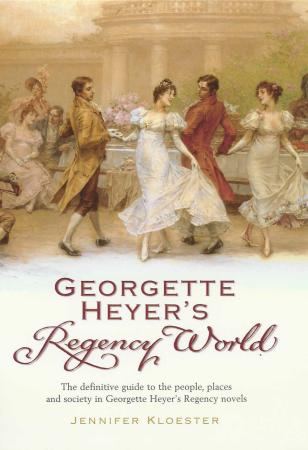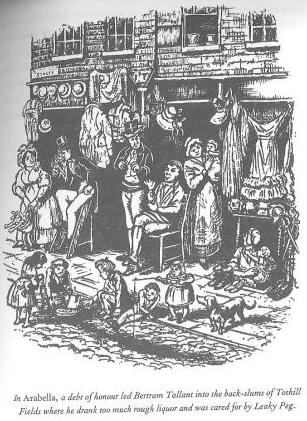
- Info
- Who is she?
- Heyer's 1984 bio
- Heyer's 2011 bio
- Who am I?
- Visit The Pump Room
- Subscribe to Updates
- Novels
- Romances, Historicals
- Mystery
- Other writings
- Random read
- Fun
- Generally
- Quizzes
- Movies
- The Challenge
- Get some!
- Buying Books?
- Heyer's World
- Heyer's Regency
- Figurines
- Links
- Heyer Sites
- Regency Info
- Regency Reading
Georgette Heyer's Regency World
by Dr Jennifer Kloester
Chapter 11: Drinking by Day and by Night.

Alcohol was an inherent part of Regency life that cut across all classes and although excessive drinking was very much a male indulgence, both sexes considered it perfectly acceptable to drink alcohol during both day and night. Water was generally eschewed as a beverage, mainly because of uncertainty about its quality and the dangers associated with drinking dirty or contaminated water. In The Foundling, Mr Shifnal was shocked when the Duke of Sale asked for water in preference to alcohol. Milk was sometimes drunk in the morning or at bedtime but was more often used in cooking. Tea, coffee and chocolate were the preferred drinks at breakfast although many men like to take ale with their morning meal. Wine was drunk at other meals and Madeira, burgundy, claret, sherry and brandy were the drinks of preference throughout the day and into the evening, while port was generally reserved as an after-dinner drink. The custom of separation between men and women - so prevalent during the Regency - was also manifested in the types of drinks deemed suitable for the two sexes. Carefully brought-up girls might decline to drink at all in certain circumstances or else choose to nurse a glass of punch or champagne at an important social event if unsure of the effect on their senses. The heroine of Arabella was greatly relieved when the butler removed her glass of wine and replaced it with a goblet of lemonade when she dined with Mr Beaumaris at his shooting-box. The exclusive Almack's club was well-known for its 'insipid' liquid refreshments of claret-cup, orgeat, tea and lemonade, but these were considered the drinks most suitable for debutantes. Claret-cup was made by mixing claret with soda, fruit juices and sugar, sometimes with brandy added, and was generally served chilled. Orgeat was distilled from barley or almonds and orange flower water and was intended as a light, refreshing drink. Tea and lemonade were, of course, non-alcholic drinks, with lemonade made from large quantities of lemon juice mixed with sugar and water. The other common ladies' drink was ratafia, a liquer flavoured with either peach, apricot or cherry kernels or with the essence of bitter almonds. In Friday's Child, Lord Sheringham ordered ratafia for Hero (and burgundy for himself) to toast their wedding. Women also sometimes drank porter, a type of bitter-tasting beer, dark brown in colour and brewed from brown malt. It was considered by some to be a healthful drink and very strengthening.
 In general, upper-class women did not get drunk, although the
prevalence of alcohol in society sometimes made this difficult. The
arrack-punch served at Vauxhall Gardens was drunk by both men and women,
despite a reputation for potency. It was said to have been made from
the grains of the Benjamin flower mixed with rum and was freely
imbibed on gala nights. Some men preferred to mix their own punch as
Freddy did in Cotillion and rum
punch (rum, lemon, arrack and sugar), Regent's punch (various fruits, rum,
brandy, hock, Curaçao, Madeira and champagne) and Negus (port,
lemon, sugar and spices) were popular brews. Fortified wines such
as Madeira and sherry were also popular with men and some women during
the Regency but red wines such as claret, burgundy and port tended
to be the more exclusive province of male drinkers. Brandy, gin and rum
were drunk by upper-class men, although they often chose to drink the
rougher forms of these spirits in the less salubrious surroundings of the
inns and taverns of the poorer quarters of London.
In general, upper-class women did not get drunk, although the
prevalence of alcohol in society sometimes made this difficult. The
arrack-punch served at Vauxhall Gardens was drunk by both men and women,
despite a reputation for potency. It was said to have been made from
the grains of the Benjamin flower mixed with rum and was freely
imbibed on gala nights. Some men preferred to mix their own punch as
Freddy did in Cotillion and rum
punch (rum, lemon, arrack and sugar), Regent's punch (various fruits, rum,
brandy, hock, Curaçao, Madeira and champagne) and Negus (port,
lemon, sugar and spices) were popular brews. Fortified wines such
as Madeira and sherry were also popular with men and some women during
the Regency but red wines such as claret, burgundy and port tended
to be the more exclusive province of male drinkers. Brandy, gin and rum
were drunk by upper-class men, although they often chose to drink the
rougher forms of these spirits in the less salubrious surroundings of the
inns and taverns of the poorer quarters of London.
Drunkenness was common, particularly among young men for whom it was deemed an acceptable condition. To engage in a revel-rout, wine party or a spread (where an undergraduate invited up to a hundred other students to a drinking party) was practically a requirement of an Oxbridge education. Among upper-class men, to be inebriated was not only acceptable but, in some circles, expected - although to be drunk in the middle of the day as Dysart frequently was in April Lady was not considered appropriate behaviour for a well-bred man. The propensity for men to drink heavily after the evening meal made it a well-established custom for the ladies to leave the table at the end of dinner and withdraw, at which point the doors were locked and the port brought to the table. Not everyone drank to excess but of those who did it was quite usual for two or three men to drink as many as eight bottles of wines such as claret, burgundy or champagne at a single sitting.
Copyright © Jennifer Kloester 2005